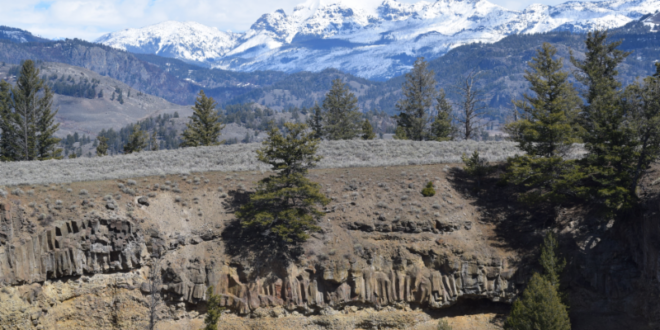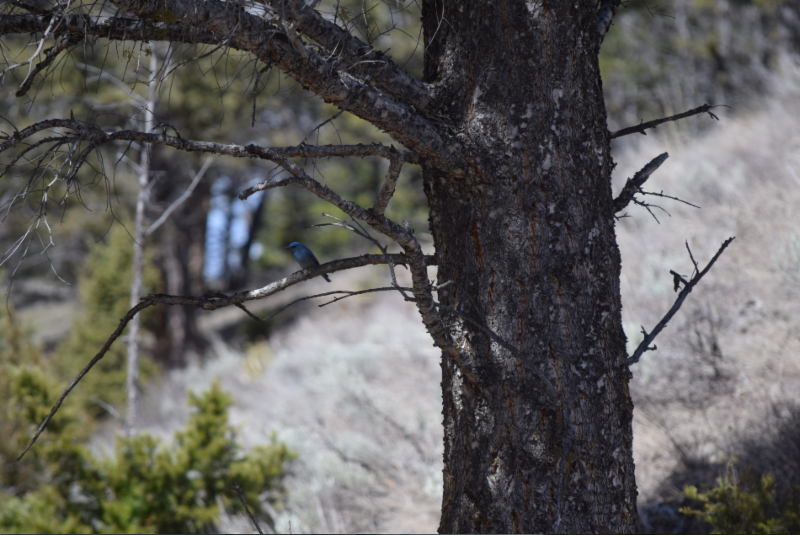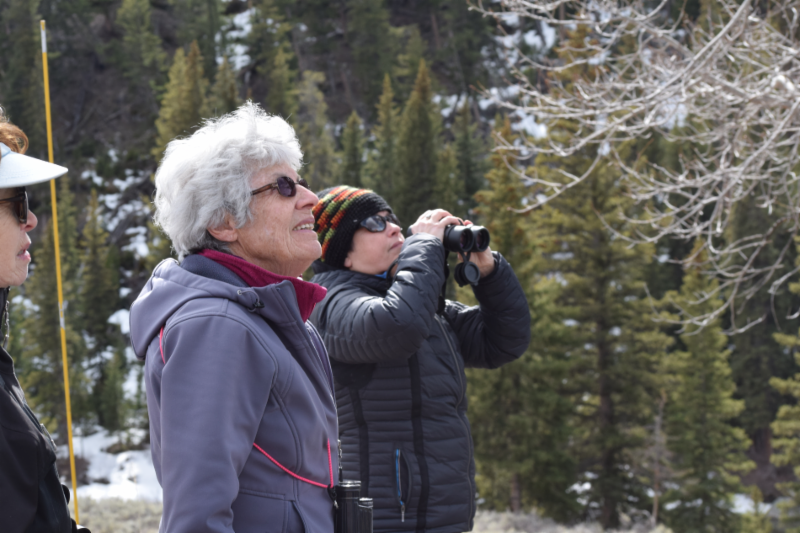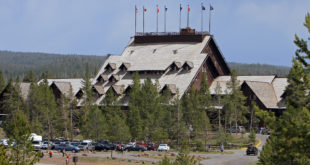It’s almost spring in Yellowstone, and small numbers of local tourists are already showing up on the park’s Northern Range.
The road through the Northern Range, from Mammoth Hot Springs to Cooke City, is open year-round to wheeled vehicles. It’s the only route in and out of Cooke City and Silver Gate in the winter, making it a roadway with a weird mixture of tourists dawdling over animal jams and scenic views, skiers on the way to trailheads, and rigs towing snowmobiles on a mad rush to Cooke City.
But in the spring, with the snowmobile season winding down, a Sunday afternoon drive from Mammoth to Lamar Valley is a pretty low-key affair, with lots of local license plates.
I headed out Sunday to check out the sights. Thinking I might make it as far as Cooke City or otherwise encountered skiable snow, I threw my cross-country skis in the way-back of the Subaru just in case.
And I packed some leftovers for lunch. Opportunities for food — as well as civilized restrooms, which a buddy calls “holding out for porcelain” — are pretty scarce on the ground this time of year. There’s a grocery store and a couple of open restaurants in Gardiner and a small general store at Mammoth, and that’s it for food and porcelain all the way to Cooke City. Don’t be caught without snacks and beverages. Tis the season to be self-contained.
The day was mostly sunny with temperatures in the 50s, creating one of those quintessential Yellowstone days of warm sun and a cool breeze — the kind of weather where you strip down to your shirt sleeves in the sun and zip your jacket back up when you’re in the shade.
The first thing that caught my attention was at the North Entrance station. A sign said Boiling River was already closed, perhaps for the entirety of the spring run-off season. I called the park’s Public Affairs Office the next day to ask what was up. The Gardner River didn’t look anywhere close to high water and was still running a clear green color.
Last summer, a park spokeswoman told me the park uses data from the USGS gauging station near Boiling River to help them make the call when it’s time to close — or open — the popular swimming hole to the adoring public.
When the flow reached 380 cubic feet per second, the park closed the river in spring. And in the summer, when the water had dropped to 200 cfs and stayed there for three days, it reopened.
But the Gardner was only at about 190 cfs on March 28. So what’s the deal?
Park spokeswoman Linda Veress said streamflow isn’t the only factor in closing Boiling River to the public. In this case, swimmers have to cross a section of cold water to reach the warm water, and the cold-water section was running pretty fast, she said. Whether or not the swimming hole will remain closed throughout the spring, she couldn’t say for sure at this point. Here’s a link to the USGS site to follow the Gardner River’s streamflow: https://waterdata.usgs.gov/mt/nwis/uv/?site_no=06191000&PARAmeter_cd=00060,00065,00010
When traveling in the Yellowstone area, it’s always a good idea to keep a hotpotting bag packed just in case. Even if Boiling River is closed, there’s always the possibility of stopping at Chico Hot Springs Resort for a soak and a snack at the Poolside Grille.
There were numerous small herds of bison in the open terrain east of Mammoth. I kept my eyes open for baby bison, the proverbial “little red dogs” of Yellowstone’s buffalo herds. It’s a little early for baby bison, but not too early to hope and to start checking the herds for the earliest arrivals.
There’s a spot between Mammoth and Tower where many have spotted a grizzly bear recently. I deduced, from a new, temporary stretch of “Don’t park here” signage, that I had identified the grizzly bear locale. But he wasn’t around on Sunday afternoon.
I parked my car at Tower Junction, where the road splits off toward Lamar Valley. The road to Tower Fall was still closed to vehicles, but it was open for walking. I saw a lot of cars and encountered several groups who had walked up to Tower Fall, a distance of about 5 miles roundtrip. The road is mostly uphill and had a few shady, still snow-covered spots, but was otherwise bare pavement. I decided to walk up to the Calcite Springs Overlook, about a mile up the road. I knew it wasn’t far, so I took a big swig from my water bottle and opted to leave it in the car.
The overlook peers into the Grand Canyon of the Yellowstone and the river’s emerald green waters. An occasional hint of hot spring scent wafts up, a reminder of the warm, sunny days of Yellowstone to come.
I was thrilled to spot my first mountain bluebird of the season, a male swooping through the trees along the roadside. I snapped a photo with my 55-200 lens, hoping that he’d show up as more than a blue blur if I zoomed in on him and cropped the photo tight.
I took a spin out toward Lamar Valley, where more bison were lounging or chowing down on recently greened grass in the meadows. Not long after I turned back toward Mammoth, I pulled over when I spied a Yellowstone Forever tour bus with its passengers outside the bus with spotting scopes up.
Turns out they were on a tour with an old friend, a retired National Park Service naturalist and bird expert, Katy Duffy (pictured above). They had stopped in a large pullout over the Lamar River with a rock cliff and large coniferous trees just across the river. They were looking at a red-tailed hawk that lived in an area where the hawks and great gray owls jockey for position on ideal nesting sites, either in the trees or in the rock cliffs. A redtail swooped by high overhead. Eleanor Clark, on the bus and who is also another retired NPS staffer, said they had seen robins, a great gray owl, Clark’s nutcrackers, horned larks and flickers during their wanderings.
Another vehicle pulled in, with the aptly-monikered “CORVID” on the personalized license plate. “Corvid,” of course, being the Latin name for the family of birds that include crows, ravens, magpies and jays. It turns out the occupant, Rob Petty, is the new education director for the Yellowstone Forever Institute.
Soon, the interior park roads will start to open. The first stretch, Mammoth to Old Faithful and West Yellowstone, is scheduled to open April 21. Lots of area locals will be out that weekend, and at least until the throngs arrive later this summer, the park will seem to belong to area locals, and we’ll catch up with old acquaintances at pullouts across the park.
 Yellowstone Insider Your Complete Guide to America's First National Park
Yellowstone Insider Your Complete Guide to America's First National Park









You must be logged in to post a comment.